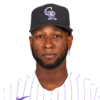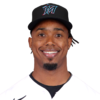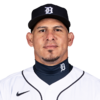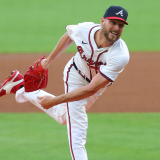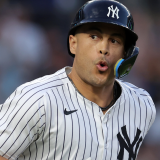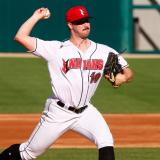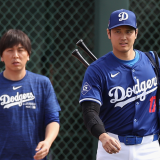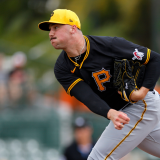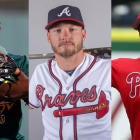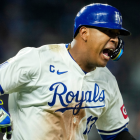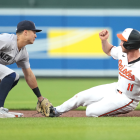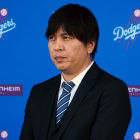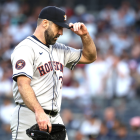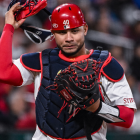The Cactus League and Grapefruit League seasons are in full swing and, three weeks from Thursday, the 2019 MLB regular season will begin. The Red Sox are looking to become the first back-to-back World Series champions since the 1998-2000 Yankees, the Dodgers are trying to get over the hump following back-to-back World Series defeats, and baseball fans everywhere eagerly await the arrival of super-prospect Vladimir Guerrero Jr. It's going to be a fun season. For sure.
The offseason never seems to end these days -- five of our top 50 free agents remain unsigned, including two of the top 12 -- but, for all intents and purposes, the biggest moves have already happened. Dallas Keuchel and Craig Kimbrel are the only needle-movers available and who knows when they'll sign. For the most part, rosters are set, and teams know what players they will break camp with. Roster issues have been addressed to what each team deems the best of their abilities.
With the regular season creeping closer, it is time to rank my favorite moves of the 2018-19 offseason. My favorite moves and the best moves are not necessarily the same thing. For my money, the Padres signing Manny Machado and the Phillies signing Bryce Harper were the best moves because they are 26-year-old stars, and prime-aged stars are the best kind of players to build around. My favorite moves tend to be less splashy, but potentially offer big production.
Here are my favorite moves of the winter, ranked authoritatively. Some of them may have been lost in the shuffle (i.e. the Machado and Harper hoopla) in recent weeks but I think all of them were sneaky great moves with a chance to pay big dividends.
1. Athletics get Profar in three-team trade
Re-signing Jed Lowrie never seemed all that likely for the Athletics for financial reasons, leaving them with two options at second base. One, roll with erstwhile top prospect Franklin Barreto, or two, go out and get someone else. The A's have weirdly kept Barreto at arm's length the last two years, so they went out and got someone else. That someone else: Jurickson Profar.
On Dec. 21 the Athletics acquired Profar in a three-team, seven-player trade with the Rangers and Rays. What the Rangers sent to the Rays and vice versa is irrelevant from Oakland's perspective. For the A's, the trade breaks down like so:
- A's get: IF Jurickson Profar
- A's give up: RHP Emilio Pagan, IF Eli White, Competitive Balance Round A pick, $750,000 in international bonus money
The draft pick (and associated bonus pool money) is the most valuable asset the A's gave up in the trade. It is currently the 39th overall selection in June's amateur draft. That draft pick represents a prospect who, in the best case scenario, is two or three years away from the big leagues. Oakland's window to win is right now. Profar helps them now and the draft pick does not, so of course the A's were willing to give up the pick for immediate MLB help.
Other than the pick, the Athletics gave up maybe their seventh best reliever (Pagan), a good but not great prospect (White), and a bunch of international bonus money they couldn't really spend. They couldn't spend it because all the top international prospects had signed by time the trade went down, and also because the A's were limited to $300,000 bonuses as part of the penalties for excessive international spending in previous years. The international money was easy to part with.
Without subtracting anything of note from their big league roster, the Athletics added a just turned 26-year-old middle infielder who authored a .254/.335/.458 batting line with 35 doubles, 20 home runs, and 10 stolen bases last year. Profar was baseball's top prospect in 2013, before shoulder trouble cost him the 2014 and 2015 seasons, and last year was the first time he was truly healthy since his top prospect days. Look at his hard hit rate:
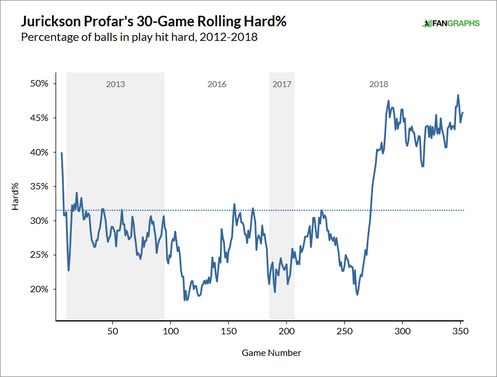
Development is not linear. There are often bumps in the road, even for the very best prospects, and Profar hit some huge bumps with his shoulder trouble. He's healthy now though. He's healthy, he produced last year, and the underlying indicators are strong. Profar hits the ball hard and he doesn't strike out a whole lot -- his 14.8 percent strikeout rate last year was comfortably better than the 22.3 percent league average -- and he's a switch-hitter who can play pretty much anywhere. And he's only 26.
So many contending clubs needed second base help this offseason that I assumed a smart big money club like the Dodgers or Nationals or Yankees would muscle their way into the mix and pick up Profar. Instead, the smart small market team beat them to it. Profar had the long-awaited breakout last year and looks poised to take another step toward becoming one of the game's elite players in 2019. The A's getting him and his two years of team control while giving up nothing they'll miss is my favorite move of the offseason. I love it.
2. Phillies acquire Segura (and much more)
This past offseason had a very unusual feel for the Phillies. In a vacuum, they made a series of very strong moves leading into the start of spring training, but, if they hadn't signed Bryce Harper, it would've felt like a giant disappointment. Now that they've signed Harper, we can say with certainty it was a great offseason. Before Harper, things were a little dicey there.
Among the moves the Phillies made prior to the Harper signing was landing shortstop Jean Segura in five-player trade with the Mariners on Dec. 3. Carlos Santana and J.P. Crawford went to Seattle for Segura and relievers Juan Nicasio and James Pazos. The Mariners won 89 games last year and decided a rebuild was required, so they shed payroll and bought low on a once highly regarded prospect in Crawford. From their perspective, the trade is mission accomplished.
The Phillies were never a Bryce Harper or Manny Machado away from being a World Series contender. This is a team that went 80-82 last year, after all. They needed to upgrade several positions, and Segura is one of the most productive shortstops in baseball. For all intents and purposes, Crawford's upside is what Segura is today. That's the best case scenario there. The Phillies traded a potential future Segura for the real Segura and moved their timeline up.
Over the last three seasons Segura has hit .308/.353/.449 with 100 doubles, 41 home runs, and 75 stolen bases in nearly 1,900 plate appearances. His park adjusted 116 OPS+ during that time is better than every full-time shortstop except Corey Seager, Carlos Correa, and Francisco Lindor. Add in good defense and you have a comfortable 4 WAR shortstop who will play the entire 2019 season at age 29 and is owed $60.4 million the next four years. That is a very good price for his age 29-32 seasons.
There are two other aspects of this trade that shouldn't be overlooked. First, Nicasio and Pazos are two nice bullpen pieces who add depth, and every contender needs depth. They were nice gets as the second and third pieces in the trade. And secondly, this move gets Rhys Hoskins out of left field. Last season 256 players played at least 500 defensive innings in the field. Here is the bottom of the Defensive Runs Saved leaderboard:
252. RF Nicholas Castellanos, Tigers: -19 DRS
253. SS Xander Bogaerts, Red Sox: -19 DRS
254. LF Rhys Hoskins, Phillies: -24 DRS
255. 3B Miguel Andujar, Yankees: -25 DRS
256. CF Charlie Blackmon, Rockies: -28 DRS
Give Hoskins an A for effort. He tried. But putting a career first baseman in left field was bound to hurt the team's defense, and it did absolutely that. Sending Santana to the Mariners opens up first base for Hoskins. The Phillies more than replaced Santana's offense with Harper and Andrew McCutchen. The Segura trade improved the shortstop position, added bullpen depth, and greatly improved their outfield defense.
Giving up on Crawford had to be a tough pill to swallow -- to be fair, I don't think trading a prospect for a player of Segura's caliber means you've "given up" on the prospect, you just have to give something to get something -- but, with the Phillies ready to make the jump from rebuilder to contender, the trade was an easy call. They traded Crawford for his best case scenario and added one of the top all-around shortstops in the game. The bullpen depth and Hoskins returning to first base was icing on the cake.
3. Mets sign Ramos to two-year deal
Quality catchers are extremely hard to find and this past free agent class offered two of them in Yasmani Grandal and Wilson Ramos. The Mets signed Ramos to a two-year deal worth $19 million on December 18, or only $750,000 more than the Brewers will pay Grandal for one year. Grandal's great! He's a big upgrade over the Manny Pina/Erik Kratz catching tandem because he has a lot of power, and because he's a great pitch-framer, which fits well with a pitching staff that lives on the corners.
Ramos is not far behind Grandal on the "best catcher in baseball" pecking order though, if at all. Will he hit .306/.358/.487 again like he did last year? Probably not. But Ramos is a career .273/.317/.439 hitter who has averaged 19 homers per 130 games, and he's hit .298/.343/.483 in nearly 1,200 plate appearance the last three years. At age 31, Ramos is still in his prime and it is not unreasonable to expect him to maintain a similar performance the next two years.
Defensively, Ramos rates as a good framer and a good thrower, so he's an all-around contributor. He's going to help the Mets offensively and defensively, and Ramos has long been regarded as a strong clubhouse guy. That is never a bad thing. The Mets could use a little leadership with David Wright's playing career over. Ramos at three years and $12 million per year would've been a great signing. Two years and $19 million total is a steal.
4. Astros sign Brantley to two-year deal
I am a bit surprised the Astros didn't do more to address their rotation aside from signing Wade Miley to a sensible one-year contract. Charlie Morton left as a free agent, Dallas Keuchel might leave as a free agent, and Lance McCullers Jr. will miss the season with Tommy John surgery. The 'Stros will roll with Miley, Collin McHugh, and an internal fifth starter candidate behind the two horses, Justin Verlander and Gerrit Cole. I expected another rotation addition.
I was not surprised the Astros added a quality left-handed bat over the winter. I thought they were a sleeper team for Bryce Harper -- Houston did try to acquire Harper at last year's deadline, remember -- though that never materialized. Instead, the Astros imported longtime Indians outfielder Michael Brantley on a two-year, $32 million contract on Dec. 19. One-hundred-and-twenty-two players batted at least 1,000 times the last two seasons. Brantley's ranks:
- Batting average: .305 (6th)
- On-base percentage: .362 (28th)
- Slugging percentage: .459 (54th)
- Strikeout rate: 10.9 percent (2nd)
- Zone contact rate: 96.7 percent (1st)
No player in baseball made more contact on pitches in the strike zone than Brantley the last two years -- Jose Peraza is a distant second at 94.1 percent -- and only Andrelton Simmons (8.9 percent) struck out less often than Brantley the last two seasons. Getting the bat on the ball consistently is a skill that is becoming increasingly difficult to find.
Brantley has never been a huge power hitter, he's more of a doubles guy than a home run guy, but the batting average and on-base ability make him a top 30 hitter in baseball. Even if he's only a top 75 hitter for his age 32-33 seasons in 2019-20, getting him at $16 million annually is quite a deal for a World Series contender that sorely lacked left-right balance in their lineup. Now manager A.J. Hinch can roll a batting order that looks like this:
- CF George Springer (RHB)
- 3B Alex Bregman (RHB)
- 2B Jose Altuve (RHB)
- SS Carlos Correa (RHB)
- LF Michael Brantley (LHB)
- 1B Yuli Gurriel (RHB)
- DH Tyler White (RHB)
- RF Josh Reddick (LHB)
- C Robinson Chirinos (RHB)
Reddick was the team's only left-handed batter of note before the Brantley addition. The Astros would probably be better off using Brantley at DH rather than left field, though he won't kill them defensively, so it's not a huge concern. Point is, the Astros spent not a lot of money to add a very potent and very contact heavy left-handed bat to their righty-leaning lineup. In this age of sky-high strikeout rates, contact reigns supreme, and Brantley offers it in spades.
5. Braves sign Donaldson to one-year contract
The only reason I'm not higher on the Braves signing Josh Donaldson is his recent injury history and the lack of the DH. Shoulder and calf problems have limited Donaldson to 165 of 324 possible games the last two years, including only 52 games last year. The Braves won't be able to give him those "half days off" at DH every now and then, preserving his legs during the long season. Johan Camargo is a Grade-A backup plan. I just wish he wasn't the backup plan everywhere on the field.
Anyway, at the end of the day, the Braves added a potential MVP caliber producer on a one-year contract, and that is never a bad move. Yes, it's an expensive one-year contract ($23 million), but it's still a one-year contract, and the Braves have plenty of money. In fact, their projected Opening Day payroll is currently down from last season despite 90 wins and a division title, and a two-year-old ballpark. The payroll decline is another matter for another time though.
Donaldson will play the entire 2019 season at age 33, so he's not so deep into his 30s that age-related decline is a significant concern, and he is only one year removed from a .270/.385/.559 batting line with 33 homers in 113 games. You needn't look back far to see the last time he was an impact player. Also, Donaldson was back to being his typical self after returning from the disabled list last year, albeit in a very small sample size:
| PA | AVG/OBP/SLG | Strikeout Rate | Hard Contact Rate | |
|---|---|---|---|---|
Before disabled list | 159 | .234/.333/.417 | 27.7% | 37.2% |
After disabled list | 60 | .280/.400/.520 | 16.7% | 50.0% |
The good version of Donaldson is still in there. We saw it last year following the injuries and his trade to the Indians*. Everything in baseball starts from the ground up. You need a solid base underneath you to do anything (hit, pitch, etc.) and last year Donaldson did not have that base. His calf was barking all summer. I'd like the Donaldson signing even more if the Braves could occasionally get him off his feet while keeping his bat in the lineup at DH, but what can you do? Some Donaldson is better than no Donaldson.
* Raise your hand if you forgot Donaldson was an Indian last year (raises hand)
I usually stick to the measurables and things we can quantify, but I'd be remiss if I didn't mention that Donaldson on a one-year contract with a chip on his shoulder really excites me. He is a very proud person who is looking to show everyone he is not done as an impact player. Donaldson is playing for a contract, he's motivated, and he's moving into a ballpark that has been hitter friendly in its two years of existence. Even if it doesn't work out, a one-year contract for a player like Donaldson is never a bad move for a contending team. This is a great roll of the dice for Atlanta.
Honorable Mention: Nationals acquire Yan Gomes; Athletics sign Marco Estrada; Brewers sign Yasmani Grandal; Twins sign Marwin Gonzalez; Reds acquire Kyle Farmer, Matt Kemp, Yasiel Puig, and Alex Wood; Reds acquire Tanner Roark; Phillies sign David Robertson; Indians acquire Carlos Santana and Jake Bauers







